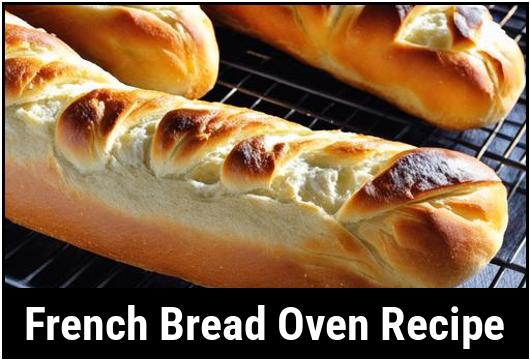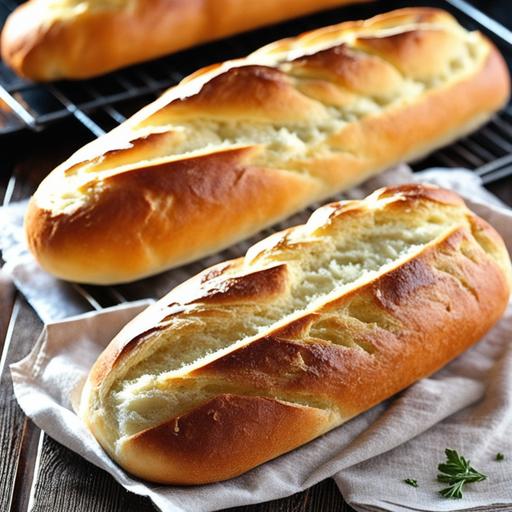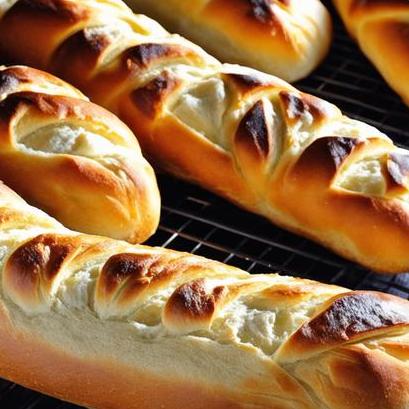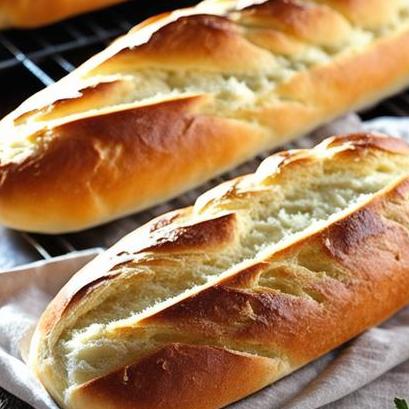
French Bread Oven Recipe: A Guide To Baking The Perfect Loaf
Indulge in the aroma of freshly baked bread with this comprehensive guide that divulges the secrets behind a flawless French bread oven recipe. Get ready to embark on a culinary adventure as we explore the food science, culinary details, selection, cleaning, preparation, tips, variations, doneness checks, and more. Discover how to achieve the ideal level of crispness on the crust and an airy, chewy crumb that will impress even the most discerning bread connoisseurs.
The Science Behind Perfect French Bread
French bread, with its light and airy crumb contrasted by a crisp crust, is a result of the perfect balance of food science and culinary expertise. It all starts with understanding the role of four key ingredients:
-
Flour: Opt for bread flour, known for its high protein content. The gluten in the flour provides structure and elasticity to the dough.
-
Water: Hydration is vital for the formation of gluten. Use room temperature water to activate the yeast and enhance their fermentation process.
-
Yeast: Active dry yeast is the most common option. Ensure the yeast is fresh and activate it by dissolving it in the water with a pinch of sugar.
-
Salt: Besides adding flavor, salt helps to control yeast fermentation and strengthens the dough.
Selecting the Best Equipment
Being prepared with the right tools is an essential part of the French bread baking process. Here are a few items you will need:
Dutch Oven:
A cast-iron Dutch oven is an ideal choice for achieving a crispy crust. Its ability to retain heat and steam during baking facilitates a professional-quality result.
Baking Stone or Steel:
Investing in a quality baking stone or steel can greatly improve your loaves. They evenly distribute heat, resulting in a consistent bake and perfectly browned crust.
Bread Lame:
A bread lame is a small, razor-sharp blade used to score the surface of the bread. This helps control the loaf’s expansion during baking, resulting in a more appealing shape.
Preparing Your Oven

To create the perfect environment for baking French bread, we need to preheat our oven and ensure its cleanliness.
Preheating the Oven:
Start by preheating your oven to an impressive 475°F (245°C). It’s important to allow your oven to heat thoroughly before placing the dough inside to achieve an optimal rise and a beautifully crisp crust.
Cleaning the Oven:
A clean oven translates to better-tasting bread. Before starting the baking process, make sure to clean any debris, grease, or spills from previous baking sessions. A clean oven also prevents any unwanted odors from seeping into your bread.
Preparation and Tips for a Stellar French Bread

Now that we have the scientific knowledge and the necessary equipment, let’s dive into the preparation process for your French bread masterpiece.
Mixing the Dough:
In a large mixing bowl, combine the flour, water, yeast, and salt. Mix until a shaggy dough forms. Knead the dough for approximately 10 minutes until it becomes smooth and elastic.
Fermentation:
Shape the dough into a ball and place it in a lightly oiled bowl. Cover it with a damp cloth and allow it to rest in a warm, draft-free area until it doubles in size. This typically takes around 1 to 2 hours, depending on the room temperature.
Shaping and Scoring the Loaf:
Once the dough has risen, gently transfer it onto a well-floured surface. Divide the dough into two equal portions and shape them into desired loaf shapes. Score the top of the loaves with a bread lame or a sharp knife, creating decorative slashes that will give your bread its signature artisanal look.
The Baking Process:
Using a baking peel or a parchment-lined baking sheet, transfer the shaped loaves onto the preheated baking stone or steel. Place the cast-iron Dutch oven with its lid on top of the dough to create a steam chamber. The steam generated helps create the crisp crust. Bake for approximately 20 minutes with the lid on, then remove the lid and bake for another 15-20 minutes, or until the loaves turn a beautiful golden brown.
Checking for Doneness

To ensure your French bread is perfectly baked, follow these doneness checks:
-
Visual cues: The bread should have a deep golden-brown crust.
-
Thump test: Gently tap the bottom of the loaf; it should sound hollow, indicating the interior is fully baked.
-
Internal temperature: Utilize a food thermometer, inserted into the center of the loaf. It should read between 190°F to 205°F (88°C to 96°C).
Tips and Variations

To elevate your French bread baking experience, here are some useful tips and variations to experiment with:
-
Adding herbs and spices: Enhance the flavor of your bread by incorporating herbs like rosemary, thyme, or spices such as garlic or onion powder into the dough.
-
Adding cheese: For a delightful twist, add shredded cheese like Gruyère or Parmesan directly into the dough. It creates a delectable cheesy interior.
-
Seeded crust: Before scoring the loaves, sprinkle a mixture of sesame seeds, poppy seeds, and flaky sea salt on the tops. This adds texture and visual appeal.
Avoiding Overcooking and Undercooking
While baking French bread, it’s important to strike the perfect balance. Here are some common pitfalls to avoid:
-
Overcooking: Be mindful of baking time. Extended baking can result in a tough crust and dry crumb. Keep a close eye, especially during the final minutes.
-
Undercooking: Undercooked loaves often have a dense texture and pale crust. Make sure the bread has enough time to develop the necessary structure and color.
A Classic French Bread Recipe
Now, let’s put our newfound knowledge into practice with this classic French bread recipe:
Ingredients:
-
4 cups bread flour
-
2 ¼ teaspoons active dry yeast
-
2 teaspoons salt
-
1 ½ cups warm water (around 110°F/43°C)
Instructions:
-
In a large mixing bowl, combine the flour, yeast, and salt.
-
Gradually add warm water to the mixture while stirring until the dough forms.
-
Knead the dough on a well-floured surface for about 10 minutes, until it becomes smooth and elastic.
-
Form the dough into a ball and place it in a lightly oiled bowl. Cover with a damp cloth and allow it to rise until doubled in size (around 1 to 2 hours).
-
Preheat your oven to 475°F (245°C) and place a baking stone or steel on the middle rack during the preheating process.
-
Once the dough has risen, gently transfer it onto a floured surface. Divide it into two equal portions and shape each portion into a loaf.
-
Score the tops of the loaves with a bread lame or a sharp knife.
-
Carefully transfer the loaves onto the preheated baking stone or steel.
-
Place a cast-iron Dutch oven or a baking dish with its lid on top of the loaves to create a steam chamber.
-
Bake for approximately 20 minutes with the lid on, then remove the lid and bake for another 15-20 minutes, until the loaves develop a deep golden-brown color.
-
Once baked, transfer the loaves to a cooling rack and allow them to cool completely before slicing.
Conclusion
Congratulations! You are now armed with the knowledge and skills required to create a stunning French bread using a simple oven recipe. As you experiment and refine your technique, don’t hesitate to explore various flavors and shapes. Remember, the key to achieving perfection lies in patience, precision, and practice. So, gather your ingredients, preheat your oven, and immerse yourself in the art of French bread baking!
Sources
FAQS On French Bread Oven Recipe
What Type Of Oven Is Best For Making French Bread?
A traditional bread oven or a conventional oven with a baking stone are both great options for making French bread.
How Long Should I Preheat The Oven Before Baking French Bread?
It’s important to preheat the oven for at least 30 minutes before baking the French bread to ensure a crisp crust and a well-risen loaf.
Should I Use A Steam Method When Baking French Bread?
Yes, using a steam method during the first few minutes of baking helps create a crispy crust on the French bread.
What Is The Ideal Temperature For Baking French Bread In The Oven?
The ideal temperature for baking French bread is around 450°F (230°C) to 475°F (245°C) for a crispy crust and a soft interior.
How Can I Tell If The French Bread Is Fully Baked In The Oven?
You can check if the French bread is fully baked by tapping the bottom of the loaf – it should sound hollow. Additionally, the internal temperature of the bread should be around 200°F (93°C) when it’s fully baked.



